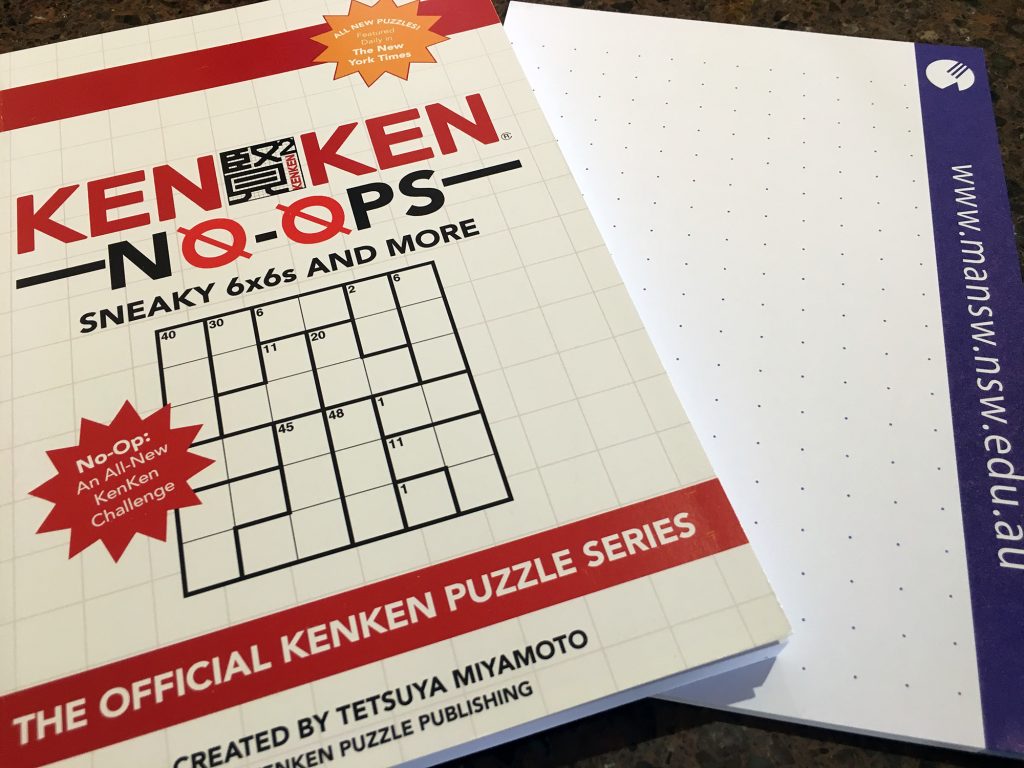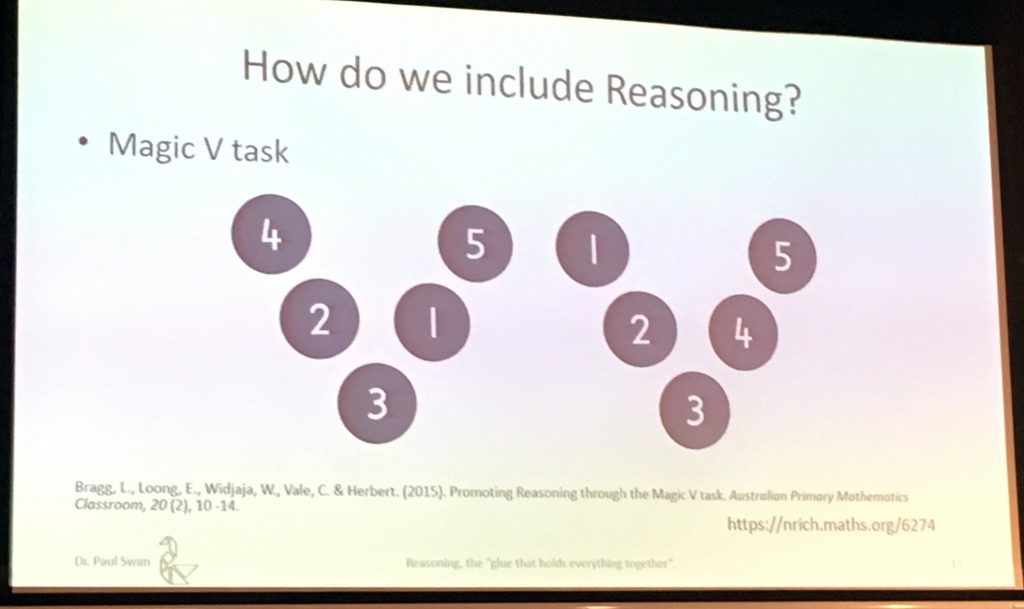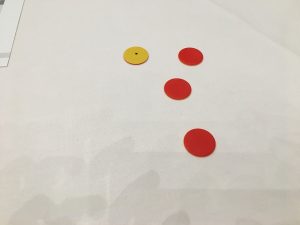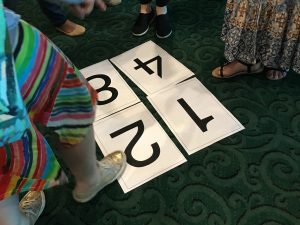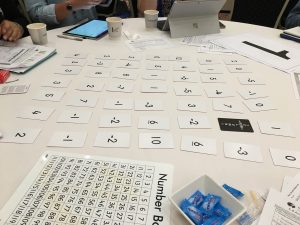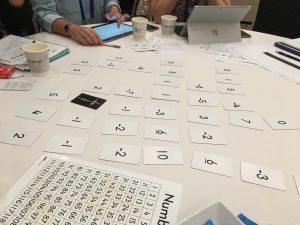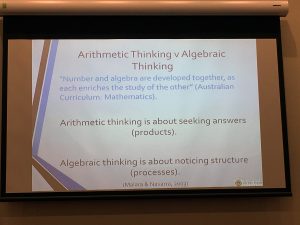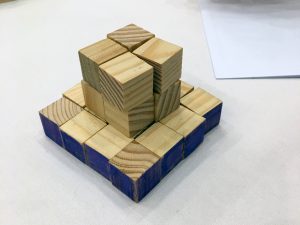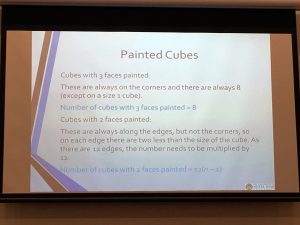Missed out on attending MANSW‘s Primary And Middle years (PAM) K-8 conference on the weekend? Well here are some of my reflections and take-away messages from the conference. It was once again a great conference where teachers (both primary and secondary), mathematics educators and researchers came to share their classroom practices and mathematical insights.
This year’s theme was Getting Reasoning Right: Reasoning Beyond Explaining and reasoning was definitely delivered in spades! Algebraic reasoning, spatial reasoning, arithmetic reasoning, adaptive reasoning, mathematical reasoning, the list went on … If you were already exicted by the awesome line-up of speakers, then the goodies in the conference bag would have sent you over the edge. Apart from the usual pen and paper, there was a KenKen® book and grid paper – this bag was a maths-nerd’s dream!
Paul Swan’s opening keynote took us on the journey of reasoning, a journey that for many students, takes time. Students need time to build thoughts upon thoughts as they make sense of the mathematics the reasoning will follow. Paul also spoke of the language required to reason and that students need to use a “bunch of words” to describe a concept. However, some students do not have the words, the vocabulary, to reason. Students may be able to ‘do the calculation’ but not have the words to communicate the thinking. There is a ‘literacy overlay’ of gestures, pictures and symbols that also need interpreting beyond just the numbers.
Paul Swan reasoning takes time “... not done in the confines of a 40 minute lesson...” @MathsNSW #mathematicalreasoning pic.twitter.com/GBZR1Imsi1
— katherin cartwright (@kath_cartwright) 29 March 2019
He explored the multiple facets of reasoning, that it’s beyond just thinking and requires a context. Students need to reason about something, content for example, statistical reasoning, spatial reasoning or numerical reasoning.
“Reasoning doesn’t exist on its own, you need to reason about something.”
Paul encouraged us to ‘raise our noticing’ by changing our routines to assist students in increasing their repertoire of words to use when describing their mathematical thinking. He mentioned the use of Number Talks, nrich tasks, using rich tasks such as Rich Tasks and Work Samples and the book “Would you rather?” by John Burningham as ways to promote and increase reasoning-talk in the classroom.
“Big ideas take a while to gestate.”
Paul talked about reasoning as the glue that holds everything together and cleverly interwove the story of the inventor of post-it notes, Dr Spencer Silver throughout his talk. Post-it notes were an idea that took almost three decades to come to fruition, an idea that didn’t stick (pardon the pun) for many years. In developing reasoning students’ thinking may have to shift, they may have ups and downs, and there may be times where it doesn’t seem to be working before it all makes sense.
I went to a number of other fantastic, engaging sessions that both extended my understanding of reasoning and provided a range of practical strategies and activities to use in the classroom with students. Below are a few reflections from each session.
Reasoning in the Early Years – What it looks like (Paul Swan)
- Lulu, Hawaiian game – using counters labelled 1 to 4, shake, drop and count total then reason about how students knew the total
- Domino Trains – using one set of dominos make ‘trains’ with 10 passengers (same numbers must match up) can you make 10 with 4 carriages? what about a train of 20 with 5 carriages?
- KenKen – coloured-coded to assist students with looking at combinations (see Paul Swan’s website for resource)
- Number Hokey Pokey – exploring adding numbers to 15 using 1, 2, 4 and 8, one foot per four students allowed on each number, extending reasoning to allow 2 feet, now what numbers can you make?
The missing link: The literacies of mathematics (Paul Swan)
- the literacies of mathematics that impact reasoning: language (vocab), graphics and symbols
- when solving problems and reasoning “you are going nowhere if you don’t understand the vocabulary”
- when planning lessons think of the language needed for students, discuss this and make it visible as part of the ‘tuning’ of the lesson that may take place after the warm-up/ ignition task
- Use of Get it Together or Group Solutions style tasks to elicit reasoning, versions of these on Paul Swan’s website Check the Clues
- students’ literacy level may impact on both ‘getting it through’ (teacher to student – receptive) and ‘getting it across’ (student to teacher – expressive)
- Rowco this is a great game by Paul Swan that focuses on number knowledge and strategic moves relating to rows and columns of numbers
Algebraic reasoning: It is about noticing structure (Lorraine Day)
- @BUBBLINGDAY reminded us of the difference between arithmetic and algebraic reasoning and that each should enrich the structure of the other
- algebraic reasoning requires students to be able to move flexibly between multiple representations
- Lorraine highlighted that using 100 is valuable “if you can do this for 100 you can generalise this forever”
- what do the numbers mean in a pattern or rule? “noticing the structure rather than noticing how the numbers work”
- “the best rule is the one that carries the meaning”
- “too often we go to the symbols and they [the students] don’t associate the words to it” using representations like the ‘n’ number line assists students in being able to reason algebraically and connect these ideas to a visual, mathematical representation (this article by Lorraine also looks at the use of visual number lines for reasoning in number and algebra)
- During the session we also explored the painted cubes task, it was fantastic and made clear visual representations of linear and quadratic equations
Overall the conference was amazing, if you are primary teacher in NSW (either pre-service or in-service) this conference is not to be missed. The knowledge and practical ideas you will gain from attending this conference will last you through until the next one! I’m sure there are many teachers of the 270 that attended that will be trying out something new on Monday back at school. There were many other sessions on the day that I would have loved to attend, there were too many good ones to choose from! If you’d like to hear more about what people thought of those sessions, check out the following presenters on twitter: @attard_c @gould_peter @Fiona_Foley @chrissymonte @matt_skoss @Way8Jennifer @RobinNagy @MareeASkillen @maggieb2234 @krisgraham122 @SharonSammut DerekHurrell
The date for next year is Saturday 28 March so pencil it in now. If you’d like to read more about the conference, also check out the Twitter hashtag #mathematicalreasoning that was used on the day. Thanks to the MANSW team and the PAM committee for all their hard work in organising the conference!
Great set of questions shared by @chrissymonte at yesterday’s @MathsNSW conf. https://t.co/vOW6d6TzOE
— katherin cartwright (@kath_cartwright) 30 March 2019
Great Saturday turnout for the PAM K-8 @MathsNSW conference around #mathematicalreasoning 'Why did you use that strategy?' rather than just 'What strategy and how did you use this strategy?', provide Ss with time to think, grapple and talk, - reasoning takes time! #whydidyou pic.twitter.com/xd3mXVFWgA
— Ayesha Ali Khan (@missalikhan) 31 March 2019
My understanding from the day is that reasoning takes many forms but it is bound in the bedrock of communication. This could look like drawings, partner talk or games. Our responsibility is to provide a conducive environment for reasoning to flourish.
— Mark Bennett (@teachnlearnMB) 31 March 2019
